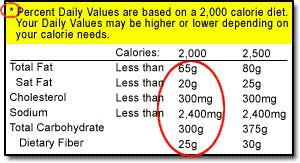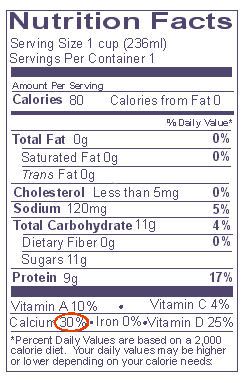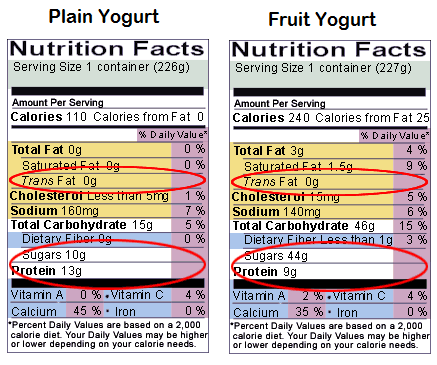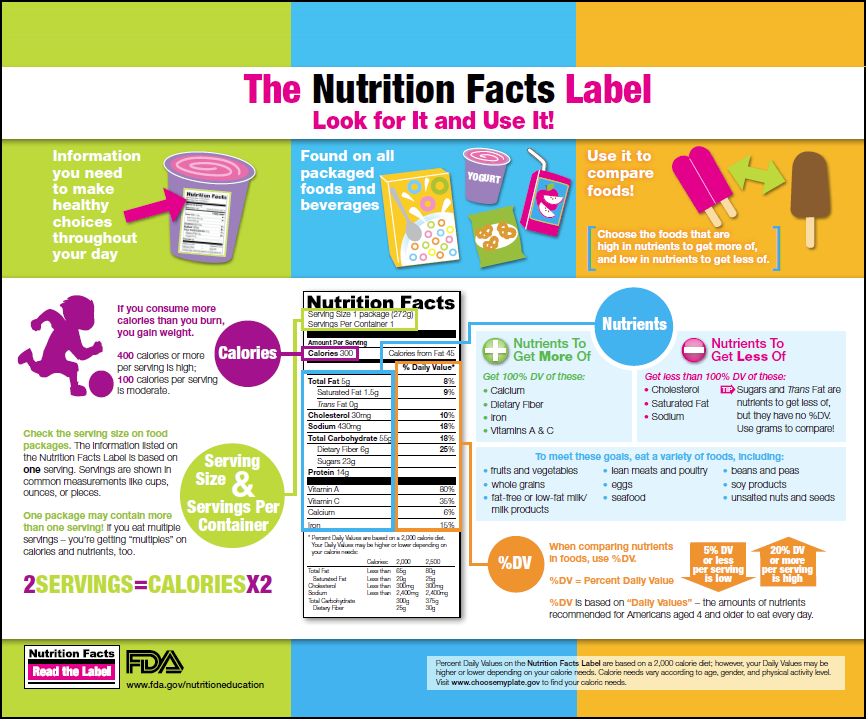This information is intended to make it easier to use the new nutrition facts label to make quick, informed food choices that contribute to a healthy diet.
The Serving Size
The first place to start when you look at the Nutrition Facts label is the serving size and the number of servings in the package. Serving sizes are standardized to make it easier to compare similar foods; they are provided in familiar units, such as cups or pieces, followed by the metric amount, e.g., the number of grams.
The size of the serving on the food package influences the number of calories and all the nutrient amounts listed on the top part of the label. Pay attention to the serving size, especially how many servings there are in the food package.
Calories (and Calories from Fat)
Calories provide a measure of how much energy you get from a serving of this food. Many Americans consume more calories than they need without meeting recommended intakes for a number of nutrients. The calorie section of the label can help you manage your weight (i.e., gain, lose, or maintain.)
Remember: the number of servings you consume determines the number of calories you actually eat.
General Guide to Calories
- 40 Calories is low
- 100 Calories is moderate
- 400 Calories or more is high
The General Guide to Calories provides a general reference for calories when you look at a Nutrition Facts label. This guide is based on a 2,000 calorie diet.
Eating too many calories per day is linked to overweight and obesity.
Nutrients
The nutrient section shows some key nutrients that impact on your health. The nutrients listed first are the ones Americans generally eat in adequate amounts, or even too much. Eating too much fat, saturated fat, trans fat, cholesterol, or sodium may increase your risk of certain chronic diseases, like heart disease, some cancers, or high blood pressure.
Important: Health experts recommend that you keep your intake of saturated fat, trans fat and cholesterol as low as possible as part of a nutritionally balanced diet.
Footnote on the Bottom of the Nutrition Facts Label
 Note the * used after the heading “%Daily Value” on the Nutrition Facts label. It refers to the Footnote in the lower part of the nutrition label, which tells you “%DVs are based on a 2,000 calorie diet“. This statement must be on all food labels. But the remaining information in the full footnote may not be on the package if the size of the label is too small. When the full footnote does appear, it will always be the same. It doesn’t change from product to product, because it shows recommended dietary advice for all Americans–it is not about a specific food product.
Note the * used after the heading “%Daily Value” on the Nutrition Facts label. It refers to the Footnote in the lower part of the nutrition label, which tells you “%DVs are based on a 2,000 calorie diet“. This statement must be on all food labels. But the remaining information in the full footnote may not be on the package if the size of the label is too small. When the full footnote does appear, it will always be the same. It doesn’t change from product to product, because it shows recommended dietary advice for all Americans–it is not about a specific food product.
Look at the amounts circled in red in the footnote–these are the Daily Values (DV) for each nutrient listed and are based on public health experts’ advice. DVs are recommended levels of intakes. DVs in the footnote are based on a 2,000 or 2,500 calorie diet. Note how the DVs for some nutrients change, while others (for cholesterol and sodium) remain the same for both calorie amounts.
How the Daily Values Relate to the %DVs
Look at the example below for another way to see how the Daily Values (DVs) relate to the %DVs and dietary guidance. For each nutrient listed there is a DV, a %DV, and dietary advice or a goal. If you follow this dietary advice, you will stay within public health experts’ recommended upper or lower limits for the nutrients listed, based on a 2,000 calorie daily diet.
Examples of DVs versus %DVs
Based on a 2,000 Calorie Diet
| Nutrient | DV | %DV | Goal |
|---|---|---|---|
| Total Fat | 65g | = 100%DV | Less than |
| Sat Fat | 20g | = 100%DV | Less than |
| Cholesterol | 300mg | = 100%DV | Less than |
| Sodium | 2400mg | = 100%DV | Less than |
| Total Carbohydrate | 300g | = 100%DV | At least |
| Dietary Fiber | 25g | = 100%DV | At least |
Upper Limit – Eat “Less than”…
The nutrients that have “upper daily limits” are listed first on the footnote of larger labels and on the example above. Upper limits means it is recommended that you stay below – eat “less than” – the Daily Value nutrient amounts listed per day. For example, the DV for Saturated fat (in the yellow section) is 20g. This amount is 100% DV for this nutrient. What is the goal or dietary advice? To eat “less than” 20 g or 100%DV for the day.
Lower Limit – Eat “At least”…
Now look at the section in blue where dietary fiber is listed. The DV for dietary fiber is 25g, which is 100% DV. This means it is recommended that you eat “at least” this amount of dietary fiber per day.
The DV for Total Carbohydrate (section in white) is 300g or 100%DV. This amount is recommended for a balanced daily diet that is based on 2,000 calories, but can vary, depending on your daily intake of fat and protein.
Now let’s look at the %DVs.
Percent Daily Value (%DV)
The % Daily Values (%DVs) are based on the Daily Value recommendations for key nutrients but only for a 2,000 calorie daily diet–not 2,500 calories. You, like most people, may not know how many calories you consume in a day. But you can still use the %DV as a frame of reference whether or not you consume more or less than 2,000 calories.
The %DV helps you determine if a serving of food is high or low in a nutrient. Note: a few nutrients, like trans fat, do not have a %DV–they will be discussed later.
Do you need to know how to calculate percentages to use the %DV? No, the label (the %DV) does the math for you. It helps you interpret the numbers (grams and milligrams) by putting them all on the same scale for the day (0-100%DV). The %DV column doesn’t add up vertically to 100%. Instead each nutrient is based on 100% of the daily requirements for that nutrient (for a 2,000 calorie diet). This way you can tell high from low and know which nutrients contribute a lot, or a little, to your daily recommended allowance (upper or lower).
Using the %DV
Comparisons: The %DV also makes it easy for you to make comparisons. You can compare one product or brand to a similar product. Just make sure the serving sizes are similar, especially the weight (e.g. gram, milligram, ounces) of each product. It’s easy to see which foods are higher or lower in nutrients because the serving sizes are generally consistent for similar types of foods, (see the comparison example at the end) except in a few cases like cereals.
Nutrient Content Claims: Use the %DV to help you quickly distinguish one claim from another, such as “reduced fat” vs. “light” or “nonfat.” Just compare the %DVs for Total Fat in each food product to see which one is higher or lower in that nutrient–there is no need to memorize definitions. This works when comparing all nutrient content claims, e.g., less, light, low, free, more, high, etc.
Dietary Trade-Offs: You can use the %DV to help you make dietary trade-offs with other foods throughout the day. You don’t have to give up a favorite food to eat a healthy diet. When a food you like is high in fat, balance it with foods that are low in fat at other times of the day. Also, pay attention to how much you eat so that the total amount of fat for the day stays below 100%DV.
Nutrients With a %DV but No Weight Listed – Spotlight on Calcium
 Calcium: Look at the %DV for calcium on food packages so you know how much one serving contributes to the total amount you need per day. Remember, a food with 20%DV or more contributes a lot of calcium to your daily total, while one with 5%DV or less contributes a little.
Calcium: Look at the %DV for calcium on food packages so you know how much one serving contributes to the total amount you need per day. Remember, a food with 20%DV or more contributes a lot of calcium to your daily total, while one with 5%DV or less contributes a little.
Experts advise adult consumers to consume adequate amounts of calcium, that is, 1,000mg or 100%DV in a daily 2,000 calorie diet. This advice is often given in milligrams (mg), but the Nutrition Facts labelonly lists a %DV for calcium.
For certain populations, they advise that adolescents, especially girls, consume 1,300mg (130%DV) and post-menopausal women consume 1,200mg (120%DV) of calcium daily. The DV for calcium on food labels is 1,000mg.
Don’t be fooled — always check the label for calcium because you can’t make assumptions about the amount of calcium in specific food categories. Example: the amount of calcium in milk, whether skim or whole, is generally the same per serving, whereas the amount of calcium in the same size yogurt container (8oz) can vary from 20-45 %DV.

| Equivalencies |
|---|
| 30% DV = 300mg calcium = one cup of milk |
| 100% DV = 1,000mg calcium |
| 130% DV = 1,300mg calcium |
Nutrients Without a %DV: Trans Fats, Protein, and Sugars:
Note that Trans fat, Sugars and, Protein do not list a %DV on the Nutrition Facts label.
Trans Fat: Experts could not provide a reference value for trans fat nor any other information that FDA believes is sufficient to establish a Daily Value or %DV. Scientific reports link trans fat (and saturated fat) with raising blood LDL (“bad”) cholesterol levels, both of which increase your risk of coronary heart disease, a leading cause of death in the US.
Important: Health experts recommend that you keep your intake of saturated fat, trans fat and cholesterol as low as possible as part of a nutritionally balanced diet.
Protein: A %DV is required to be listed if a claim is made for protein, such as “high in protein”. Otherwise, unless the food is meant for use by infants and children under 4 years old, none is needed. Current scientific evidence indicates that protein intake is not a public health concern for adults and children over 4 years of age.
Sugars: No daily reference value has been established for sugars because no recommendations have been made for the total amount to eat in a day. Keep in mind, the sugars listed on the Nutrition Facts label include naturally occurring sugars (like those in fruit and milk) as well as those added to a food or drink. Check the ingredient list for specifics on added sugars.
 Take a look at the Nutrition Facts label for the two yogurt examples. The plain yogurt on the left has 10g of sugars, while the fruit yogurt on the right has 44g of sugars in one serving.
Take a look at the Nutrition Facts label for the two yogurt examples. The plain yogurt on the left has 10g of sugars, while the fruit yogurt on the right has 44g of sugars in one serving.
Now look below at the ingredient lists for the two yogurts. Ingredients are listed in descending order of weight (from most to least). Note that no added sugars or sweeteners are in the list of ingredients for the plain yogurt, yet 10g of sugars were listed on the Nutrition Facts label. This is because there are no added sugars in plain yogurt, only naturally occurring sugars (lactose in the milk).
Plain Yogurt – contains no added sugars

Fruit Yogurt – contains added sugars

If you are concerned about your intake of sugars, make sure that added sugars are not listed as one of the first few ingredients. Other names for added sugars include: corn syrup, high-fructose corn syrup, fruit juice concentrate, maltose, dextrose, sucrose, honey, and maple syrup.
To limit nutrients that have no %DV, like trans fat and sugars, compare the labels of similar products and choose the food with the lowest amount.

